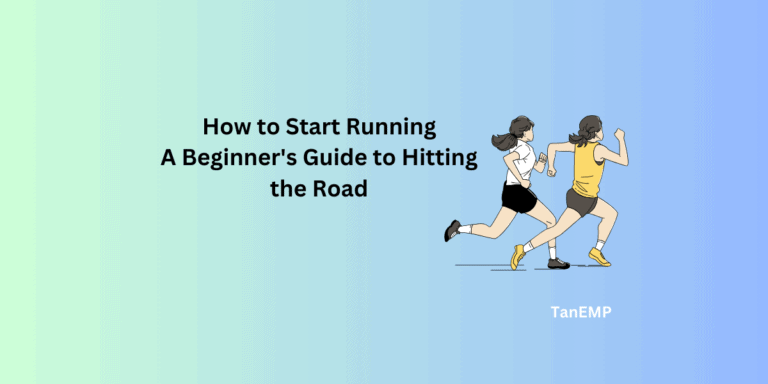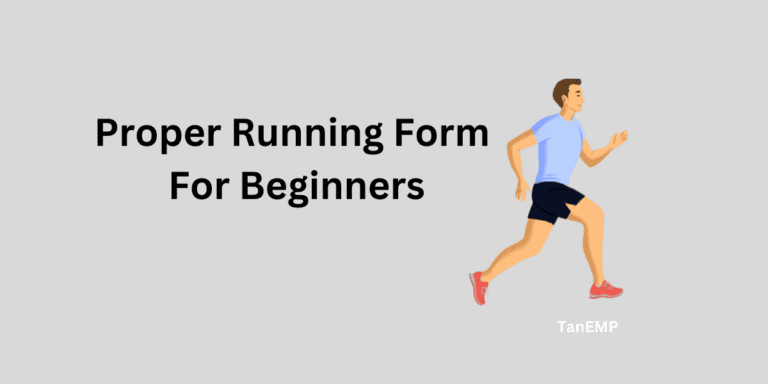How to Breathe While Running: Master the Art of Efficient Breathing in 2025
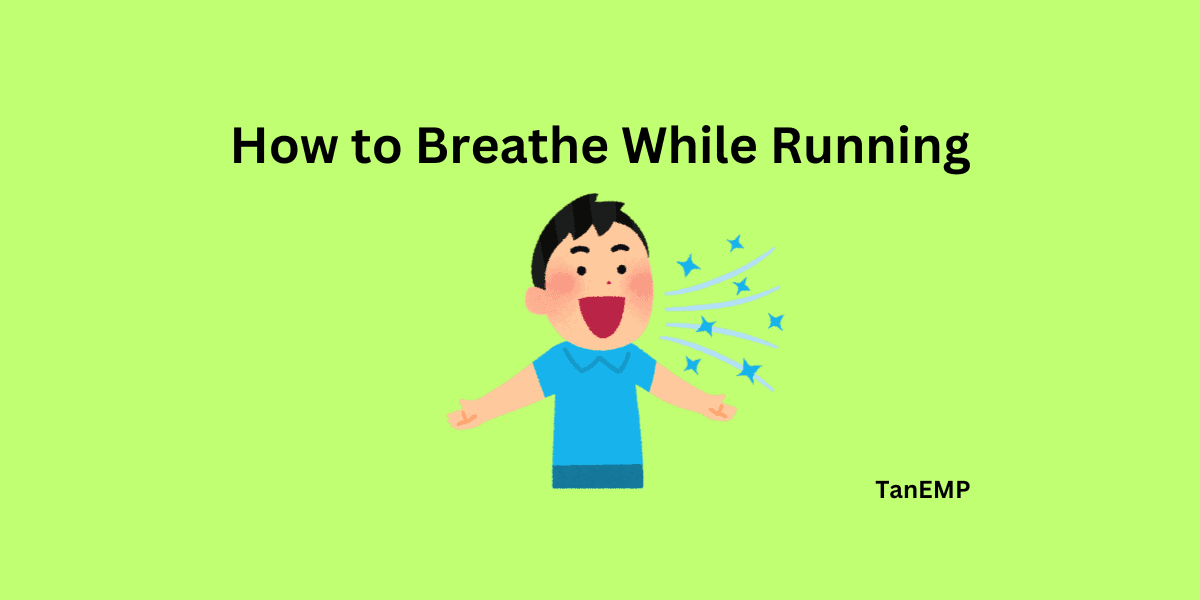
Ever feel like you’re gasping for air mid-run, wishing breathing could be as easy as taking your next step?
The key is learning how to breathe while running the right way!
Belly breathing is the secret to better running. It helps you breathe more oxygen, reduces discomfort, and improves your run.
Most people overlook how important breathing is, but mastering it can completely change how you run.
Research from the American Lung Association stated that rhythmic and belly breathing techniques improve running performance.
In my 13 years of practice, I’ve noticed that over 80% of my patients don’t breathe properly. Whether they’re desk workers who barely exercise or seasoned marathon runners, most rely on chest breathing.
Chest breathing limits the amount of oxygen your body receives, making runs more challenging and less efficient.
Key Takeaway
- Belly breathing is your go-to technique. It allows deeper, more efficient breaths, giving your muscles the oxygen they need to keep moving.
- Combining breathing patterns, like the 3:2 or 2:1 rhythm, can help balance oxygen intake during both steady and fast-paced runs.
- Good running form matters! Standing tall, keeping your shoulders relaxed, and leaning slightly forward can improve airflow and make breathing easier.
- Proper breathing not only improves endurance but also helps you avoid common problems like side cramps.
In this guide, we’ll explore simple breathing methods like belly breathing and rhythmic patterns to help you run better, feel stronger, and enjoy your workouts more.
Let’s dive in!
Why Is Proper Breathing Important for Runners?
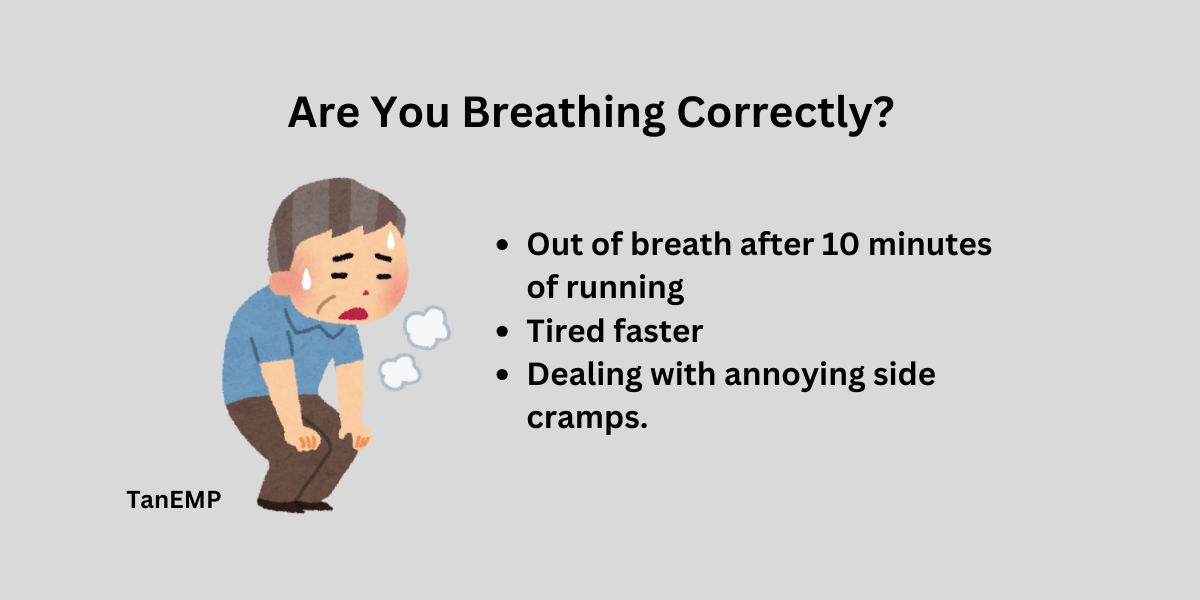
Breathing the wrong way can make running much harder. Many new or seasonal runners rely on chest breathing, where only the top part of their lungs fills with air. You may also call this shallow breathing.
So, each breath you take is has less oxygen it need to make sure your body and muscles working correctly.
As a result, you might find yourself:
- Out of breath after 10 minutes of running
- Tired faster
- Dealing with annoying side cramps.
Without enough oxygen, your body struggles to keep up, making long or tough runs feel even more challenging.
Proper breathing ensures your muscles get the oxygen they need to work efficiently. It helps you run longer, feel stronger, and avoid the discomfort caused by improper techniques.
Related Post: Tips for beginner runners
Different Types of Breathing Techniques for Runners
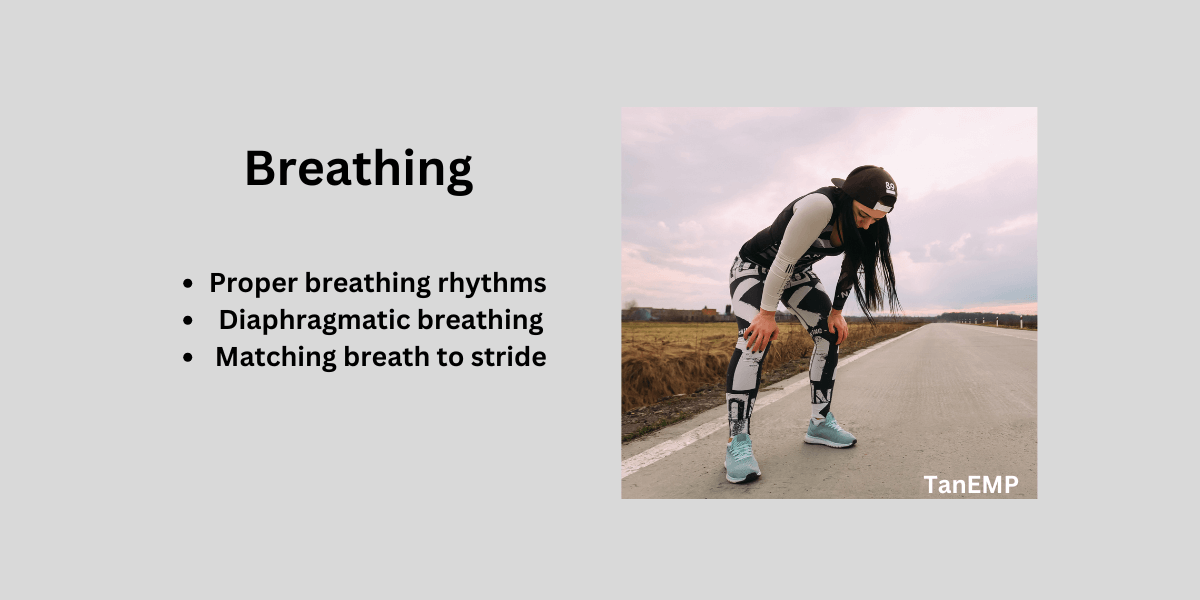
So we talk about why breathing is important in running, you may wonder what type of breathing technique is good for you.
Let’s break down the three types of breathing patterns that are beneficial to you.
Belly Breathing
This technique focuses on using your diaphragm to take deeper, fuller breaths. Instead of your chest moving, your belly expands. This helps your body get the oxygen it needs and reduces strain, so running feels smoother.
Rhythmic Breathing
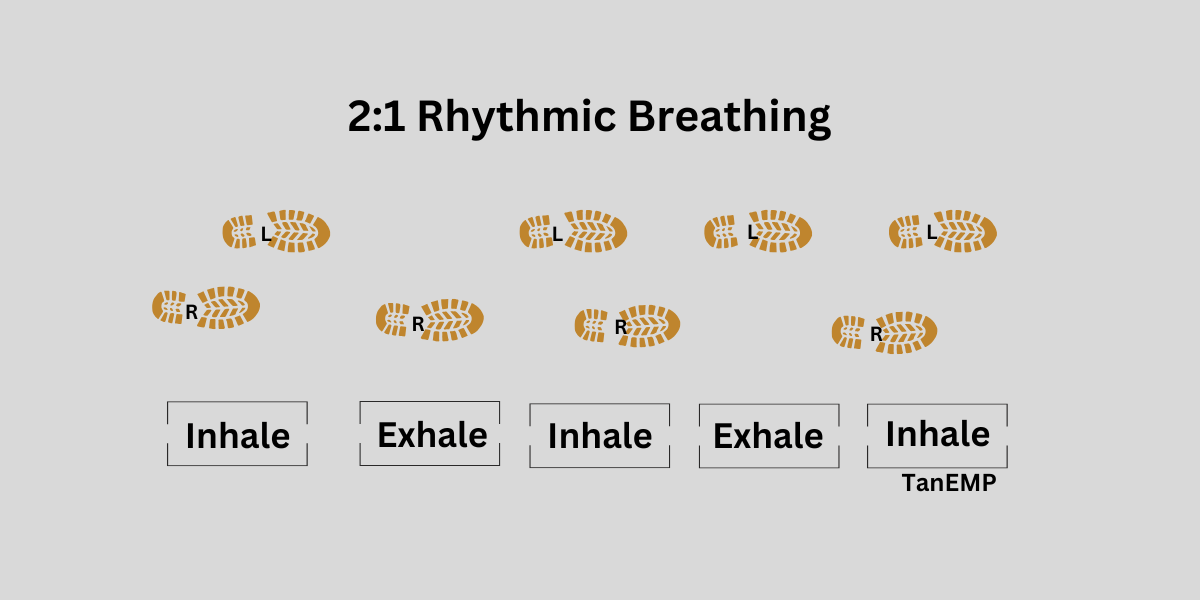
Rhythmic breathing follows a set pattern of steps and breaths to help balance oxygen intake:
- 3:2 pattern: Inhale for three steps, then exhale for two. This reduces stress on one side of your body.
- 2:1 pattern: For beginners, try inhaling for two steps and exhaling for one. It’s simpler and easier to manage when you’re just starting.
Nasal Breathing
Ideal for slower runs, nasal breathing keeps you calm and focused. Breathing through your nose filters and warms the air. If needed, you can switch to mouth breathing during harder runs.
Experiment with these techniques to find the one that fits your pace and comfort!
How to Breathe Properly While Running
I can’t emphasize enough not to breathe through your chest.
Now that you have learned the three types of breathing, which one is better?
Belly breathing
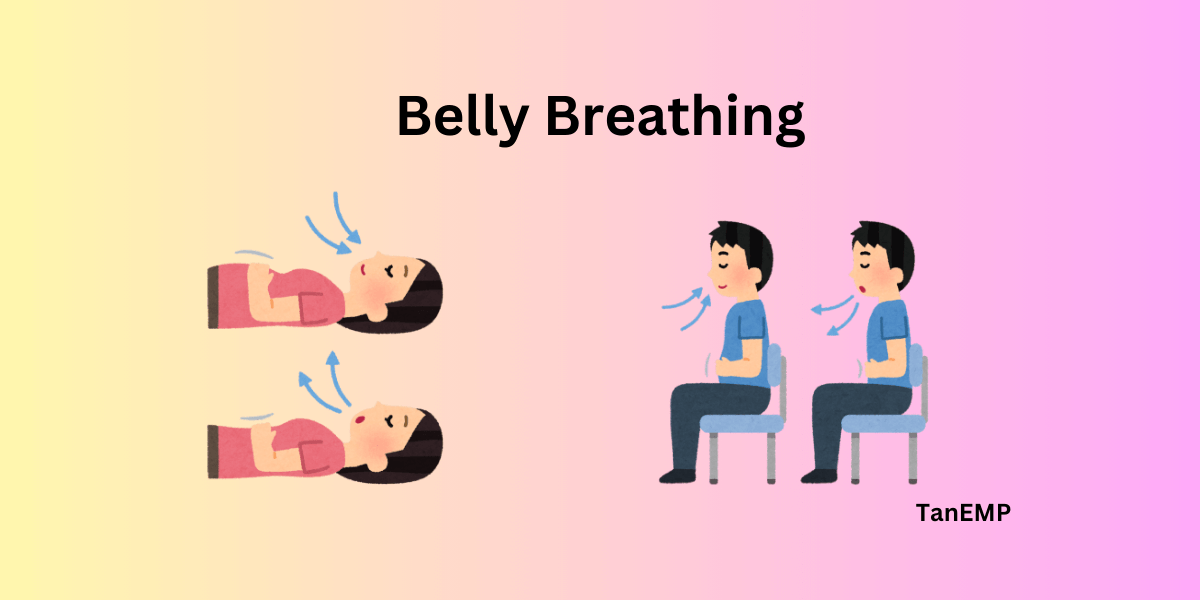
When we’re born, we naturally breathe with our bellies. As we age, we often switch to chest breathing, which limits oxygen and can lead to neck and back pain.
Long story short, belly breathing will help you run better and decrease neck and upper back pain.
Benefits of belly breathing:
- Engage your diaphragm for full, deep air
- Maximize oxygen delivery to your muscles and body for better performance
- Core muscles involve
- Lower your center of gravity for better stability
- No grasping for ai,r which may lead to a lack of oxygen
Here’s a simple way to practice belly breathing on the floor:
- For starters, without experience with belly breathing, start by lying on the floor.
- Lie on your back with your knees bent and feet flat on the floor.
- Place one hand on your chest and the other on your belly.
- Take a deep breath, like you’re blowing up a balloon. Feel the hand on your belly rise.
- If your chest hand moves instead, keep practicing until belly breathing feels natural.
- Practice 10–15 breaths every night.
Here’s a simple way to practice before your run:
- You can do this breathing during your warm-up
- Inhale deeply through your nose, letting your belly rise (breathe in slowly for 2 seconds)
- Exhale fully through your mouth (breathe out slowly for 2 seconds).
- If unsure, place a hand on your stomach and another on your chest. Your belly should move more than your chest.
- Breathe for 10-15 breaths before you start running
Common Breathing Mistakes for New Runners
Let’s talk about breathing mistakes that might be making your runs harder than they need to be.
Here are the most common breathing problems to watch out for:
- Holding your breath without realizing it. This traps bad air (carbon dioxide) in your body and makes running feel much harder.
- Use just your upper chest to breathe. Your lungs need more space to fill up with air properly
Another thing many runners do is try to force their breathing into a specific pattern. But here’s the thing, your body already knows how fast it needs to breathe!
Let your breathing match your running speed naturally.
The fix is simple: breathe normally and listen to your body. If you’re gasping for air, it’s okay to slow down. Try the belly breathing technique mentioned above.
Remember, good breathing habits take 6-8 weeks to develop. Don’t rush!
Breathing Tips To Make Your Run Natural

Want to breathe easier on your runs? Here’s how to make it feel more natural!
#1 Start by warming up your breathing muscles:
- Take slow, deep breaths while you jog lightly or walk-run method
- This helps get your lungs ready for your run
#2 Watch how you stand:
- Keep your shoulders loose
- Stand up straight
- Let your core (stomach muscles) support you
#3 Try breathing from your belly:
- Focus on pushing your stomach out when you breathe in
- It might feel weird at first, but it works better than chest breathing
- This helps you get more air into your lungs
#4 Handle different weather:
- When it’s cold, Wear something over your neck to warm the air
- When it’s hot: Drink plenty of water
Don’t worry if it takes time to get used to these tips. Keep practicing, and breathing will feel easier every time you run!
Conclusion
Mastering how to breathe while running isn’t just about staying comfortable. It’s about helping your body work its best. Whether you’re just starting out or getting ready for a marathon, using the right breathing techniques can make a big difference.
Techniques like belly breathing and rhythmic patterns allow you to run longer, recover faster, and avoid problems like side stitches. They also help your muscles get the oxygen they need to keep you moving strong.
Start practicing these tips today, and you’ll feel the improvement in every step you take!
FAQs About Breathing While Running
What’s the best breathing pattern for a faster pace?
For faster runs, try the 2:1 or 3:2 breathing pattern. This means you breathe in for two steps and out for one step. It helps your body get the oxygen it needs while keeping up with your quicker stride.
If the pace feels tough, mix nasal and mouth breathing to take in more air. Play around with this pattern during your runs to find what feels natural for you.
Can poor posture affect lung capacity?
Yes, poor posture can make a big difference. When you slouch or hunch, your diaphragm doesn’t have enough space to expand fully.
This makes it harder to take deep breaths, and you end up struggling for air. Instead, stand tall and relax your shoulders. A slight forward lean when running can help your lungs work better and make breathing easier.
How can I prevent side cramps during a marathon?
Side cramps are often caused by shallow chest breathing. To avoid them, focus on breathing deeply into your belly.
Practice belly breathing on training runs so it feels natural during a marathon. Staying hydrated and warming up well also helps prevent cramps. If you do get a cramp, slow down, take deep breaths, and focus on exhaling fully to relax the muscles.


